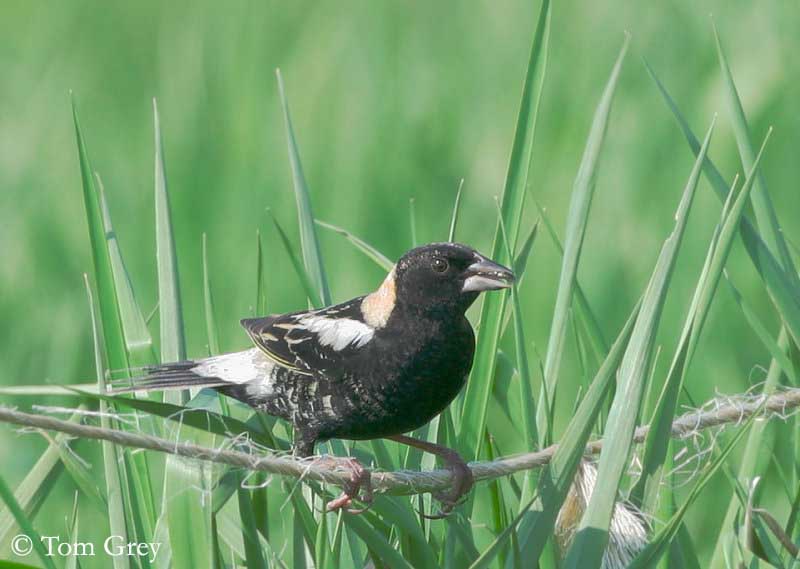
Bobolink
Dolichonyx oryzivorus
Passeriforme Order – Icteridae Family
BIOMETRICS:
Length : 15-21 cm
Wingspan : 27 cm
Weight : F : 29-40 g – M : 34-51 g
LONGEVITY : up to 9 years
DESCRIPTION:
Bobolink is a plump medium-sized bird, with a relatively short tail showing pointed tips on rectrices, and with a prominent conical bill. This species is related to blackbirds and orioles. It is the only American species with black underparts and white patches on back.

Male in breeding plumage is black with creamy-buff nape and conspicuous white scapulars and rump patch, from back to uppertail coverts. Wings are pointed, and tail feathers have spiked tips. We can see a buff stripping on back and buff edges on tertials.
Face is entirely black. Black bill is short and conical. Eyes are brown. Legs and feet are dark flesh. It has a long nail on the hind-toe.
During spring migration, male shows pale edging on black plumage.
Non breeding male has yellow-buff underparts with black streaks on flanks, back and undertail coverts. Tail and wings are brownish. On the head, black crown is separated by a yellowish line, and a fine black line extends behind the eye. Bill is pale.
Female resembles non breeding male, with duller plumage. She is browner on the head, with whitish line in centre of crown and above the eye.
Juvenile resembles female, but yellower.
Adult Bobolinks have two complete moults per year, the first in late summer-early autumn, and the second in late winter-early spring. Male and female show brighter buff colour on head and body when they are in fresh plumage. When in worn plumage, they are whitish on the sides of face and throat.
VOICE: SOUNDS BY XENO-CANTO
Bobolink’s usual call is a clear, low, liquid “pink”, given in flight. This flight call is heard year round and often repeated. Call is also a harsh “chek”.
Song is a loud bubbling and rolling series of notes, ranging for deep to high and thin, often rendered “bobolink-bobolink-bobolink…”. These notes are frequently uttered during fluttering song flights.
Song is frequently uttered during flight, but also when perched on a bush, or clinging to the top of a tall weed.
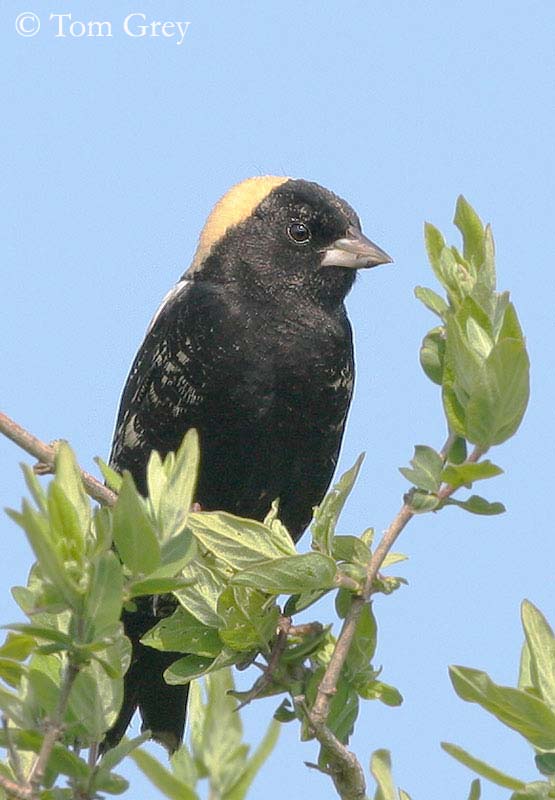
HABITAT:
Bobolink breeds in open and semi-open grassy areas. During migration and in winter, it can be found in freshwater marshes, grasslands and rice fields.
RANGE:
Bobolink breeds from southern Canada and northern United States, and southwards to Colorado, Indiana and northern New Jersey.
It winters in central and southern South America.
This species may be a very rare vagrant to Western Europe.
BEHAVIOUR:
In early 1900s, Bobolink was listed as an agricultural pest in some parts of the United States, mainly in rice fields’ areas. This species strongly damaged rice fields with very large flocks. In seven years, more of 700.000 birds were killed, and sometimes, people sold them as human food in markets. Ten years later, Bobolink populations had considerably decreased, and changes in agricultural methods had driven the species to South America.
Today, it is always a cage bird in Argentina, but it is now protected in North America.
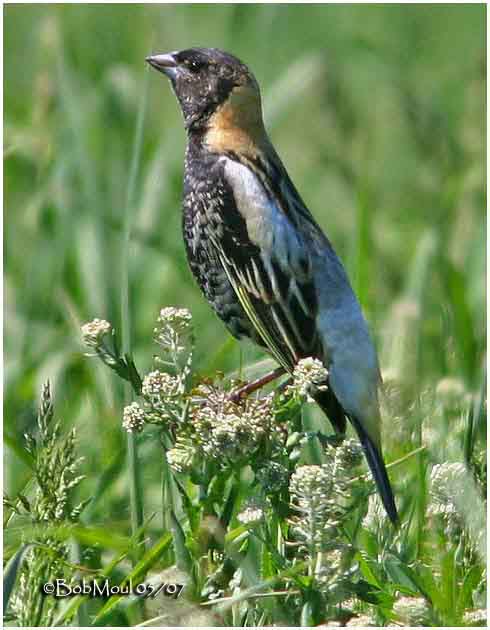
This bird feeds on insects which are agricultural pests, and also on seeds from weeds. They forage while walking on the ground.
Bobolink migrations are very long for this species. Birds fly over about 20.000 km from breeding to wintering areas and return. They migrate at night.
Bobolink feeds in large flocks in both grasslands and agricultural fields, in the centre of South America, on their wintering areas. They mainly feed on rice crops during migration to the South. But in the North, they are insectivorous. Bobolink is also named “Butter Bird”, because it is known to gorge itself in South Carolina and Georgia. Then, it becomes so fat that this species is hunted as game birds. It is also called “Rice Bird” or “Reed Bird”. But Bobolink is now protected.
Male is polygamous and may have five females nesting within its territory. Male provides food and defends the territory. When it’s possible, dominant male helps other parents in nearly territory. They are generally its own young of the previous year, or birds belonging to its family group.
During courtship displays, male is similar to blackbirds with head down, ruffled neck feathers, fanned tail, and wings arched downwards in order to display its conspicuous white shoulders’ patches.
FLIGHT:
Bobolink has strong and slightly undulating flight.
REPRODUCTION:
Bobolink nests in hayfields and meadows in spring, from May to early July. Nest is on the ground. It is a well-hidden open cup in dense vegetation, in a shallow depression at the base of a clump of grass. Exterior wall of nest is made with coarse grasses and weed stems, and lined with finer grasses. It may have a canopy of dead grass hanging over the top. Nest is built by female. The species may nests in loose colonies.
Female lays 3 to 7 bluish-grey to pale reddish-brown eggs, heavily spotted with dark. Incubation lasts about 10 to 13 days, by female. Male helps brood and feeds the young of its primary mate. Altricial chicks fledge at about 10 to 14 days after hatching. They fly at about 16 days.
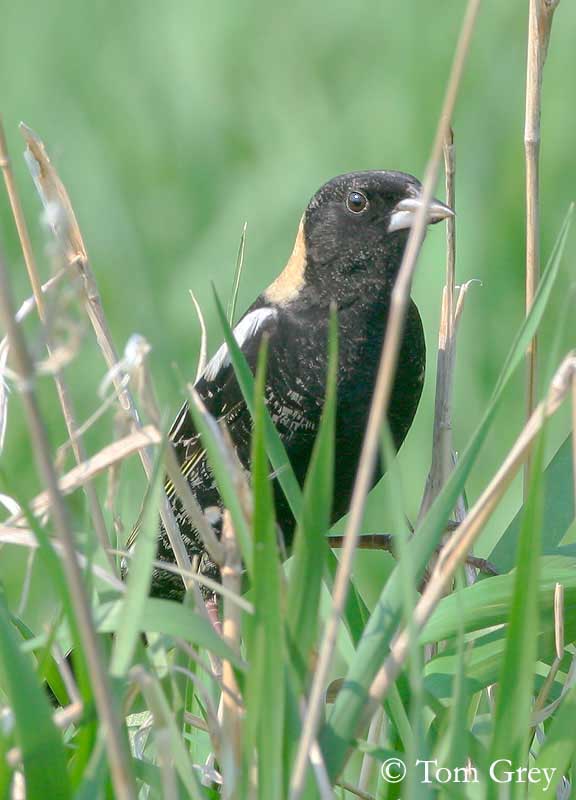
Nesting behaviour in Bobolink is particular. Sometimes, more than two adults are feeding the young at a single nest. “Helper” can be a male or a female, and may be offspring from the previous year of one or both of the other adults. They also may be adults which lost their brood, and they need to feed young.
This species produces only one clutch per year.
DIET:
Bobolink feeds mainly on seeds (rice, weed seeds and other grains), insects and also spiders. It swallows seed whole.
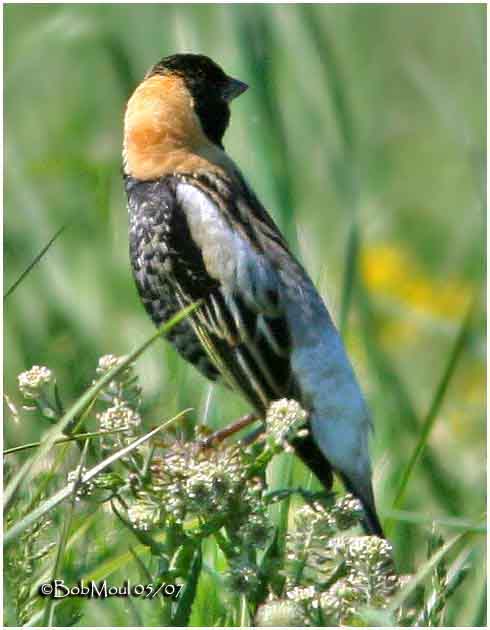
PROTECTION / THREATS / STATUS:
Bobolink populations are in decline, due to clearing of woodlands, change in agricultural practices, modernizing farmland techniques with frequent rotation of cultures. These facts have rendered cultivated areas less favourable for nesting.
Habitat loss is the most important cause of Bobolink’s decline.
Now considered as beneficial to agriculture in North America, the species is an agricultural pest in South America, damaging rice fields when feeding in large flocks.
Bobolink is also trapped as cage-bird, and shot as human food.
Fr: Goglu des prés
All : Bobolink
Esp : Soldadito Arrocero
Ital : Bobolink
Nd : Bobolink
Russe : Рисовая птица
Sd : Bobolink
Photographs by Tom Grey
His website: Tom Grey's Bird Pictures
Photographs by Bob Moul
His website:
Nature Photography
Text by Nicole Bouglouan
Sources :
NEW WORLD BLACKBIRDS – THE ICTERIDS by Alvaro Jaramillo and Peter Burke – Helm - ISBN : 0713643331
FIELD GUIDE TO THE BIRDS OF NORTH AMERICA - National Geographic Society - ISBN: 0792274512
THE HANDBOOK OF BIRD IDENTIFICATION FOR EUROPE AND THE WESTERN PALEARCTIC by Mark Beaman, Steve Madge - C.Helm - ISBN: 0713639601
All About Birds (Cornell Lab of Ornithology)
Wikipedia (Wikipedia, The Free Encyclopedia)
What Bird-The ultimate Bird Guide (Mitchell Waite)